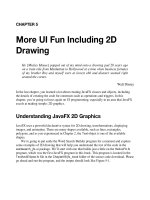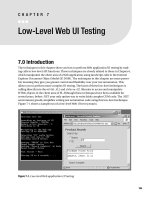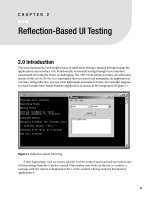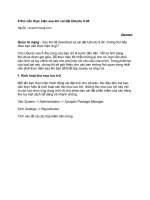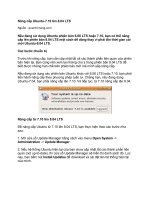04 prototype ux ui
Bạn đang xem bản rút gọn của tài liệu. Xem và tải ngay bản đầy đủ của tài liệu tại đây (11 MB, 56 trang )
PROTOTYPE – UX – UI
Lecturer. Tran Thi Que Nguyet
1
Hypothesis Testing for
Value Creation
2
Steps
●
●
●
Hypothesis statement
Test method
Test metric & criteria
Example: ScotchFinder startup
(1) We believe that people will be happy to share their scotch with others
(2) We will test this by interviewing 100 people outside of a liquor store
(3) We are right if more than 70% say that they like this idea
3
● Hypothesis statement: We believe that people will be happy to share their
scotch with others
○ Who are the people?
○ Goal: identify our first market segment (a specific group with a
specific problem)
○ Does not need to represent the entire population
● Test method: We will test this by interviewing 100 people outside of a
liquor store
○ What kind of liquor store?
○ The locations
● Test metric & criteria: We are right if more than 70% say that they like
this idea
○ Actual goal: to learn about the problems that our target group is
encountering
Revision4
Test Card
Name of test
Hypothesis
What assumption will you focus on?
Test
How will you test your hypothesis?
Metric
How will you measure the results?
Criteria
How will you know if your hypothesis is
correct?
5
Scientific Method
GUESS
COMPUTE
CONSEQUENCES
COMPARE
COMPUTATIONS
WITH
EXPERIMENTS
Name of learning card
Hypothesis
What assumption did you have?
Observation:
What did you observe?
Learning:
What did you learn?
Actions:
What are your next steps?
6
Minimum Viable Product
● “A minimum viable product is that version of a new product which
allows a team to collect the maximum amount of validated learning
about customers with the least effort.” (Eric Ries)
● Then, we put them in front of the people for whom we are trying to
create value
● Their responses will tell us if we are on the right track
è FAST and CHEAP way to REDUCE our RISK
7
●
●
●
Business model canvas
Customer development process
Agile development
Build experimentation
into product
Analyze results using
metrics driven by the
business plan and learn
Business model canvas
Hypothesis
Start interviewing
Lean startup program
8
Agile Manifesto
●
●
Agile is a set of values and principles that guide how you
should conduct innovation (from 2001)
Bring four values
○ Individuals and interactions
○ Customer collaboration
○ Responding to change
○ Working versions of products
9
Principles of Agile Manifesto
●
Principle 1: Build – Measure – Learn cycle of design sprint
●
Principle 2: Measure of improvement
●
Principle 3: Autonomous team
○
Teamwork spirit
○
Creativity, innovation, and improvement
○
Decision making: Should be empowered to make
decision
10
11
Summary
● />zZLyp4jQE9A/htmlpresent
● />● />%20%96%20UI%20introduction.pdf
● />● />
12
Prototyping
13
success
Prototype
Building without prototyping
success
Building with prototyping
14
●
●
Brainstorming
Generating potential solutions
○
○
○
○
○
○
●
●
●
Storyboarding
Sketching
Wireframe
Prototype
Mockup
Information architecture and navigation
User testing
Tools: Balsamiq, Invision, Figma, Adobe, etc.
Building on feedback - Critique
15
Storyboard
16
Storyboard
● What do you need? Paper, Pens, A bit of glue, Some post-its, Print-outs of UIelements (+ scissors)
● Online Tools:
○
/>
○
/>
○
Google sheets, draw.io
○
Video makers
● A process of time and interaction
● Prerequisites: personas, scenarios, the scope
● Elements: images, transitions, effects, voiceover, soundtrack
17
Sketching
● Sketching User Interfaces, User
Flows and UI Animations
● When you sketch, you are trying to
get a basic concept of how the app
will work in user interface form.
● Express your ideas quickly and
involve others in creating the user
experience
● Can sketch on a whiteboard or
blank sheet of paper
● Detail is not important, your trying
to establish flow
18
19
Steps
● Define what you need to draw
● Define what keyframes and
transitions you should include in
your drawing
● Define the starting point.
● Decide what comes next.
● Sketch alternative routes, entries.
● Think about alternative flows.
● Add annotations, notes, details.
20
● A wireframe is a schematic or blueprint that is
useful for helping you, your programmers and
designers think and communicate about the
structure of the software or website you're
building.
● Wireframes are used early in the development
process to establish the basic structure of a page
before visual design and content is added.
● Some tools as Sketch, Adobe XD, Axure, Visio,
balsamiq, figma, moqups, draw.io
Comparisions
/> /> />
Wireframe
21
22
23
Prototype & Mockup
● Prototype: An interactive version of wireframe
● Mockup: a beautiful version of wireframe
success
success
Building without prototyping
Building with prototyping
24
Information Architecture & Navigation
● IA defines site content and functionality, while a website’s navigation is a
collection of user interface components and patterns that helps visitors find
information and functionality.
● 8 principles
○ The principle of objects: Content should be treated as a living, breathing thing. It
has lifecycles, behaviors, and attributes.
○ The principle of choices: Less is more. Keep the number of choices to a minimum.
○ The principle of disclosure: Show a preview of information that will help users
understand what kind of information is hidden if they dig deeper.
○ The principle of exemplars: Show examples of content when describing the
content of the categories.
25



